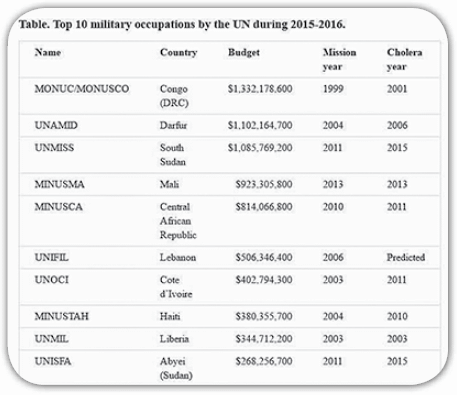|
 Like
the plantain weed,
Plantago major,
which so reliably matched the movements of European
settlers through North America that it became known as
“the white man’s footprint,” the cholera epidemics of
the last 15 years have closely followed the growth and
trajectories of United Nations troops.
Haitians have been infected not once, but at
least twice with cholera from the UN. As of this
writing, Haiti is smarting from a resurgence of cholera
that began in September 2015. The infections are
probably not due to the Nepalese strain of cholera that
caused the October 2010 epidemic but to newly introduced
cholera from Bangladesh. Recovery from an infection with
one strain of cholera does not confer immunity against
another, so the UN has sickened some unfortunate people
and their children multiple times. Before I go into the
details of the new epidemic, let us look more broadly at
the UN peacekeepers’ role as a new vector of disease in
the world.
UN Deployments Worldwide
The UN currently runs 16 military
occupations, with guidance and funds from major world
powers and the so-called emerging powers. Multinational
armies of blue helmets prey on various countries,
especially in west and central Africa, mainly to
safeguard the colonial interests of France and the
United States. Emerging powers like Canada, Brazil,
India, and South Korea tag along, salivating for seats
on the UN Security Council. Their representatives enrich
themselves on the kickbacks from contracts for lucrative
projects such as
mining, peacekeeper
training, construction, hydro-power, and textiles, which
depend on the oppression of a supply of abundant
cheap labor.
Altogether, the military occupation missions cost
more than $8 billion per year. Their names are confusing
interchangeable acronyms like MINUSCA, MINUSMA,
MINUSTAH, UNMIL, and UNMISS, and it is quite appropriate
that this should be so, because, everywhere the blue
helmets go, their activities and
atrocities are the
same. These include assaults,
rapes, arms
trafficking, human trafficking, prostitution,
murder, and the
dissemination of infections. Except in Lebanon, where
the actions of Hezbollah have kept the UN troops in
check, cholera epidemics have flared up in every country
where these troops have had a major presence since 1999.

The above table suggests that, although Haiti’s
2010 cholera was the most scandalous and best-studied
case of the UN’s introduction of an epidemic of disease
into a country, it was probably not the first such
infection nor the last. The reason for these infections
is simple: the introduction of UN troops into countries
represents a heavy burden on their infrastructure. The
sanitation on UN bases is usually shoddy, and UN troops’
untreated wastes are routinely dumped into rivers.
Furthermore, the largest
contingents of UN troops
come from Bangladesh, India, and Nepal, all of which are
South Asian countries where cholera is endemic.
I have closely monitored Haiti’s epidemic and
examined the others, and it is evident that they follow
a predictable pattern. The citizens of the invaded
countries are left to live under appalling conditions,
usually near stagnant water and uncollected rubbish,
while the UN and their associated medical
non-governmental organizations (NGO) settle into the
best living spaces and incessantly predict that the
filth elsewhere will lead to a cholera epidemic for the
native population. Simultaneously, contingents of UN
troops are allowed to
take leaves in their
countries at the height of cholera epidemics, and they
are subsequently reinserted, with little medical
oversight, into the unsuspecting populations. Whether or
not this practice is deliberately intended to trigger
epidemics, it does so as surely as an injection of a
growing bacterial culture leads to an explosion of
exponential bacterial growth in a previously sterile
broth. In the end, the victims are blamed for their
supposed poor hygiene. The UN, which has caused the
infection, not only gets away with it but recasts itself
as a savior: a provider of oral cholera vaccines, which
just happen to benefit its friends in academia with
financial interests
in the vaccines. It hardly matters that the vaccines are
useless.
One Country, Multiple Infections
Recent research in Haiti has showed
that, lately, when some Haitian cholera patients excrete
the cholera bacteria in their stools, these bacteria are
accompanied by a virus (or phage) called ICP2, whose DNA
sequence closely matches that of a virus from
Bangladeshi patients. It is certain that the Bangladeshi
virus got into Haiti on Bangladeshi strains of cholera
bacteria excreted by Bangladeshi peacekeepers. According
to
Andrew Camilli and
his colleagues at Tufts University, who first sequenced
the genomes of these viruses: “these phages also travel
with V. cholerae into the human host and are shed at
appreciable amounts by infected patients, where like V.
cholerae they could be spread to others via fecal-oral
transmission.” Bacterial
hosts of the ICP2 virus
include not only Vibrio cholerae O1 but also V. cholerae
O139, which originates from Bangladesh.
This infection of Haiti with cholera from
Bangladesh is terrible news, because the strains of V.
cholera O1 and O139 from Bangladesh are notoriously
pathogenic, usually carry multiple antibiotic
resistances, and have strong epidemic and pandemic
potential. Even after the cholera epidemic brought from
Nepal in 2010, Haitians were naïve to the Bangladeshi
cholerae and only became exposed to these more harmful
bacteria, starting in 2012, when the UN began to
introduce
female Bangladeshi
peacekeepers into Haiti as a sort of gimmick.
According to the American researchers, a cocktail
of three
Bangladeshi cholera viruses
(ICP1, ICP2, and ICP3) protects baby mice from becoming
ill after they are deliberately infected with cholera.
The researchers suggest that this viral cocktail might
prevent infections in the human relatives of cholera
patients. On the other hand it might not, and instead
make them very sick or even kill them. After all, humans
aren’t the same as baby mice. In any case, such research
that might potentially harm apparently healthy people
would be highly unethical. Who will prevent it from
being done on Haitians? Surely not the “Haitian National
Ethics Committee” that has so far approved the work of
the U.S. researchers. And who will expel the UN once and
for all and put an end to the continued infection of
Haitians with new strains of cholera?
The World Health Organization (WHO), which is
part of the UN, reported in 2015 that there are 1.4 to
4.3 million cases of cholera and 28,000 to 142,000
deaths yearly due to cholera infections. These numbers
will surely continue to climb,
proportionately with
the “peacekeeping” budgets. The WHO offers as its main
solution the stockpiling of a large number of doses of
oral cholera vaccines. Suppose for a moment that such
vaccines should work — which they do not. Would the UN
then advocate universal cholera vaccination for the
world’s poor so that they might safely drink water that
has been fecally contaminated by their invaders? The UN
has never been the highly
ethical organization
it was envisioned to become, but its enthusiastic
advocacy of oral cholera vaccines does represent a new
low.
Dady
Chery is a Haitian-born biology professor at a U.S.
university. An earlier version of this article, under a
different title, was
originally published on her blog in January.
|